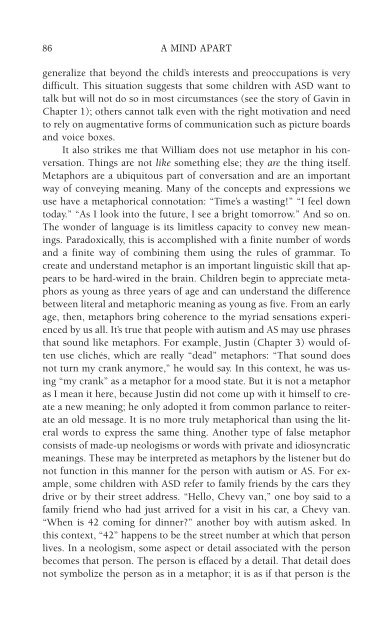978-1572305441
autism
autism
You also want an ePaper? Increase the reach of your titles
YUMPU automatically turns print PDFs into web optimized ePapers that Google loves.
86 A MIND APART<br />
generalize that beyond the child’s interests and preoccupations is very<br />
difficult. This situation suggests that some children with ASD want to<br />
talk but will not do so in most circumstances (see the story of Gavin in<br />
Chapter 1); others cannot talk even with the right motivation and need<br />
to rely on augmentative forms of communication such as picture boards<br />
and voice boxes.<br />
It also strikes me that William does not use metaphor in his conversation.<br />
Things are not like something else; they are the thing itself.<br />
Metaphors are a ubiquitous part of conversation and are an important<br />
way of conveying meaning. Many of the concepts and expressions we<br />
use have a metaphorical connotation: “Time’s a wasting!” “I feel down<br />
today.” “As I look into the future, I see a bright tomorrow.” And so on.<br />
The wonder of language is its limitless capacity to convey new meanings.<br />
Paradoxically, this is accomplished with a finite number of words<br />
and a finite way of combining them using the rules of grammar. To<br />
create and understand metaphor is an important linguistic skill that appears<br />
to be hard-wired in the brain. Children begin to appreciate metaphors<br />
as young as three years of age and can understand the difference<br />
between literal and metaphoric meaning as young as five. From an early<br />
age, then, metaphors bring coherence to the myriad sensations experienced<br />
by us all. It’s true that people with autism and AS may use phrases<br />
that sound like metaphors. For example, Justin (Chapter 3) would often<br />
use clichés, which are really “dead” metaphors: “That sound does<br />
not turn my crank anymore,” he would say. In this context, he was using<br />
“my crank” as a metaphor for a mood state. But it is not a metaphor<br />
as I mean it here, because Justin did not come up with it himself to create<br />
a new meaning; he only adopted it from common parlance to reiterate<br />
an old message. It is no more truly metaphorical than using the literal<br />
words to express the same thing. Another type of false metaphor<br />
consists of made-up neologisms or words with private and idiosyncratic<br />
meanings. These may be interpreted as metaphors by the listener but do<br />
not function in this manner for the person with autism or AS. For example,<br />
some children with ASD refer to family friends by the cars they<br />
drive or by their street address. “Hello, Chevy van,” one boy said to a<br />
family friend who had just arrived for a visit in his car, a Chevy van.<br />
“When is 42 coming for dinner?” another boy with autism asked. In<br />
this context, “42” happens to be the street number at which that person<br />
lives. In a neologism, some aspect or detail associated with the person<br />
becomes that person. The person is effaced by a detail. That detail does<br />
not symbolize the person as in a metaphor; it is as if that person is the



